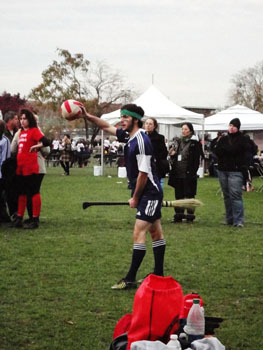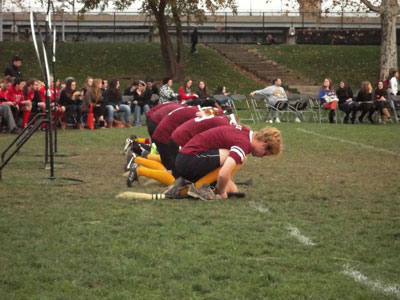Quidditch makes its way
Harry Potter’s magical game now a reality
Lauren Gilbart
Contributor
Athletes race from one end of the field to the other with sweat pouring down their faces. Sheer determination reflects in their eyes.
The crowd cheers wildly.
From an outsider’s perspective, it sounds like any other sports game.
It’s not.
If one looks closer, they would actually see university students running around the fields dressed in gold-coloured spandex with a dangling ping pong ball secured on their hindquarters.
Most importantly, they would notice these athletes are equipped with a broomstick between their legs.
Oh, it’s Quidditch.
If you’ve paused right here, wondering what the heck Quidditch is, I shake my head at you. This incredible flying sport was invented by author J.K. Rowling and was incorporated into her series Harry Potter.
You’re probably incredulously wondering how anyone can play a flying sport in real life. In most cases, your skepticism would be spot on. However, in this case, you’d be mistaking just how influential the fictitious world of Harry Potter has been.
Quidditch isn’t just for die-hard fans either. It’s played all over the world, particularly in high schools and universities. Five years ago, the Quidditch bug bit Calgary as well.
Josh Nadeau played on the University of Calgary’s Quidditch team until he recently graduated.
Even though he is no longer officially on the team, he remains very active in the Quidditch community. Currently, he is playing the sport for fundraisers, teaching Quidditch to those at The Boys and Girls Clubs of Calgary, and will soon be educating elementary students about this unique sport.
“Media attention helped bridge the gap between books and sports,” Nadeau said.
“That’s where we come in. It’s a really interesting game and it gets people incorporating more physical activity into their lives.”
Calgarian Mike Wark,a student at Carleton University but originally from Calgary said he joined his school’s Quidditch team after moving east. His decision to join had nothing to do with loyalty to Harry Potter.
“A lot of the decision to join the Carleton team had to do with the very ridiculousness of the sport and my fascination over discovering a full contact, co-ed sport combining elements of rugby, dodgeball and tag all in the same game,” Wark explained.
“As a former rugby player and cross-country runner in high school, Quidditch also intrigued me for its athletic potential. I wanted to see how this game would function, given its obvious quirks. It didn’t disappoint,” he added.
While the University of Calgary has a Quidditch team, the sport isn’t exclusive to university students. Anyone from Calgary, no matter what age or experience, is able to come out to test their athleticism.
Alison Armitage, the Headmaster of the U of C Quidditch club, says the best way to find out more about the league is to check out their Facebook page: University of Calgary Muggle Quidditch Club.
The team tries to play every three weeks, but the cold temperatures of Calgary’s winters sometimes makes it difficult to have successful games.
Even though U of C hasn’t been able to play at the Quidditch World Cup, they haven’t lost hope.
Wark and the rest of Carleton’s Quidditch team had the opportunity to play in last November’s annual Quidditch World Cup of 2011 in New York City.
Of course, seeing as Quidditch is directly connected to Harry Potter, Wark said that it’s been difficult to explain to other students that Quidditch deserves the chance to be viewed as a real sport.
The University of Calgary and Carleton University outraged some people over the idea of Quidditch being part of the university’s athletics departments. Others, like Wark and Nadeau loved the idea.
However, even skeptics can fall in love with the fast-paced game when they watch it live. The atmosphere, the Snitch (who, no matter what, always seems to steal the show) and the traditional sports fan and Harry Potter fans alike make this one incredible — one very real — sport.
Now if only we could work on the whole flying thing.
How does it work?
The book version of Quidditch is actually similar to the “muggle” version (see: non-magical), but with a few distinct changes.At the Quidditch World Cup players do not fly on broomsticks. (Yes, there really is an annual world cup.) The balls don’t fly either. Players in the “muggle” version throw the balls at each other instead.
In short, the game consists of two opposing teams of seven players — three chasers, two beaters, one seeker and one keeper.
Chasers score points by throwing a large ball called a quaffle into one of the opposing team’s three hoops.
The keeper protects those hoops, much like a goalie.
The beaters try to take out the opposing players by throwing bludgers (mid-sized balls) at the opposition in hopes of knocking them out of the game for a few minutes.
The seeker chases after the golden snitch (the person in gold running around the field).
The seeker who catches the snitch ends the game.







